TEATRO GARIBALDI
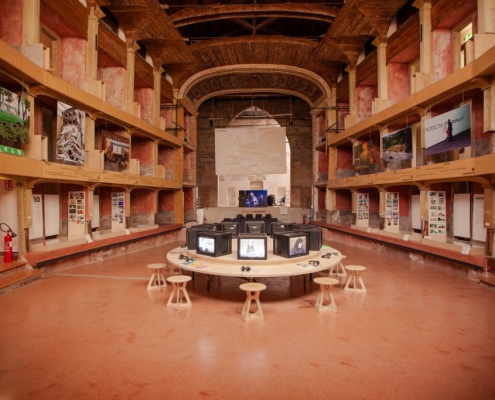
The Teatro Garibaldi in Palermo is located in the La Kalsa district, a few steps from the La Magione Basilica.
The theater was inaugurated in 1861 by Garibaldi, who gave a speech to the crowd. Since the inauguration it has undergone various transformations over the years. It remained closed for a long time and reopened only in 1906. From the mid-fifties to the early sixties it was also used as a cinema under the name “Araldo” and was later abandoned to be reopened only in the nineties.
Directed by Matteo Bavera, the Garibaldi theater has been engaged in recent years in productions and co-productions with artists such as Carlo Cecchi, Emma Dante, Peter Brook, Antonio Latella, Davide Enia and Wim Wenders.
The theater has undergone important interventions that have changed its interior; the work finished in May 2010. Between 2017 and 2018, the Garibaldi Theater was the headquarters of the 12th edition of Manifesta, a traveling biennial of contemporary art, as well as part of the event, hosting, among the other, works by Giorgio Vasta and Wu Ming.
PALAZZO CHIARAMONTE STERI (LO STERI)
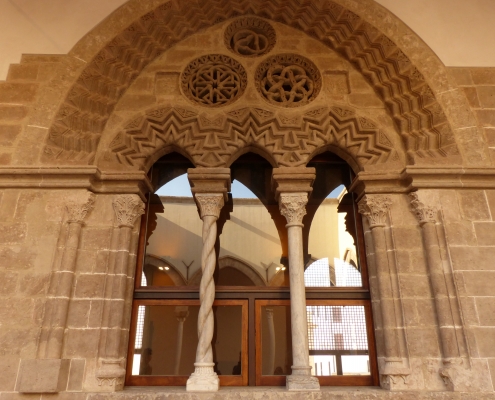 Palazzo Chiaramonte-Steri is a historical palace in Palermo.
Palazzo Chiaramonte-Steri is a historical palace in Palermo.
The building was begun in the early 14th century, and was the residence of the powerful Sicilian lord Manfredi III Chiaramonte. He commissioned the decoration of the Sala Magna (“Grand Hall”), with a painted wooden ceiling by Cecco di Naro, Simone da Corleone and Pellegrino Darena. From the late 15th century to 1517 it housed the Aragonese-Spanish viceroys of Sicily; later it was home to the Royal Customs and, from 1600 to 1782, the tribunal of the Holy Inquisition.
The palace was restored in the 20th century, with numerous elements associated with its role as a jail of the Inquisition. During the works, the grooves left by iron cages in which had been hung the severed heads of the nobles who had rebelled against emperor Charles V were discovered in the façade. The palace is now a museum; among the artworks, it houses Renato Guttuso’s Vucciria.
CHIESA DELLO SPASIMO (LO SPASIMO)
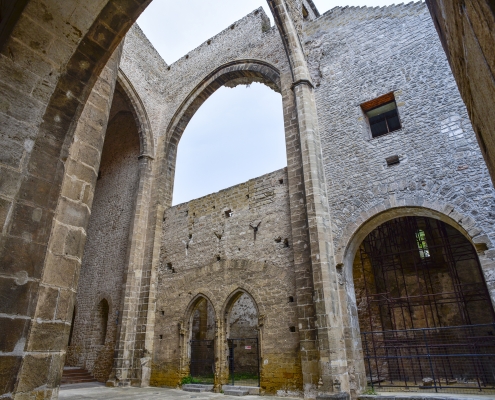
Santa Maria dello Spasimo, or Lo Spasimo, is an unfinished Catholic church in the Kalsa neighborhood in Palermo.
Construction of the church and accompanying monastery of the Olivetan Order began in 1509 with a papal bull from Julius II, on land bequeathed by Giacomo Basilicò, a lawyer and the widower of a rich noblewoman. The Spasimo or Swoon of the Virgin was a controversial idea in late medieval and Renaissance Catholic devotion. The church commissioned the painting by Raphael, Christ Falling on the Way to Calvary, or Lo Spasimo di Sicilia, as it is also known. This was completed in Rome in about 1514-165, but in 1622 the Spanish Viceroy of Naples twisted arms and obtained its sale to Philip IV of Spain, and it is now in the Museo del Prado in Madrid.
The church was never completed because of the rising Turkish threat in 1535, where resources meant for the church were diverted to fortifications of the city against any possible incursions. Even in its unfinished states, Lo Spasimo shows the late Gothic style architecture that permeated building practices in Palermo at the time as well as the Spanish influence in the city.
The church now hosts open air musical, theatrical and cultural events because of its lack of a roof.
Cre.Zi. Plus
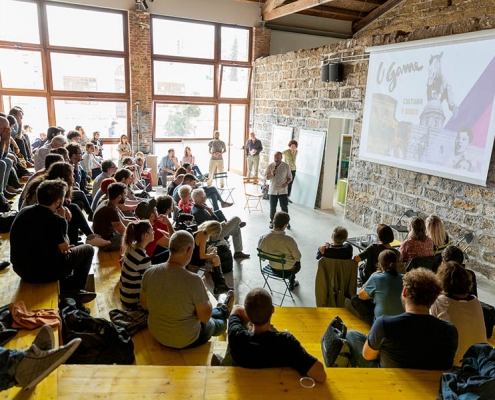 Cre.Zi.Plus is a new community hub located at Pad.10 and 11 inside Cantieri Culturali alla Zisa –an industrial archaeological complex which previously was a furniture factory and belonged to a famous Palermitan businessman Vittorio Ducrot from 1890 to 1968; it also plays an important role in urban regeneration history of Palermo.
Cre.Zi.Plus is a new community hub located at Pad.10 and 11 inside Cantieri Culturali alla Zisa –an industrial archaeological complex which previously was a furniture factory and belonged to a famous Palermitan businessman Vittorio Ducrot from 1890 to 1968; it also plays an important role in urban regeneration history of Palermo.
From the beginning, an ecosystem was launched among craftsmen, artists, and start-uppers with a common interest in supporting cultural production. Based on their main strategy of overtaking the incubator business concept, Cre.Zi.Plus is not just a working space but a community of networks where one can receive a strong support for an entrepreneurial project.
At Cre.Zi.Plus you can find more than just an office. Their aim is to create an hybrid and multi-functional space, to give full of support such as business incubator, support for developing cultural organizations, network services, fab-lab, variety of workshops and education activities, conferences, seminars, co-working, workshops for textile micro-production and design, social kitchen, restaurant, cafeteria.
CHIESA DEL SANTISSIMO SALVATORE
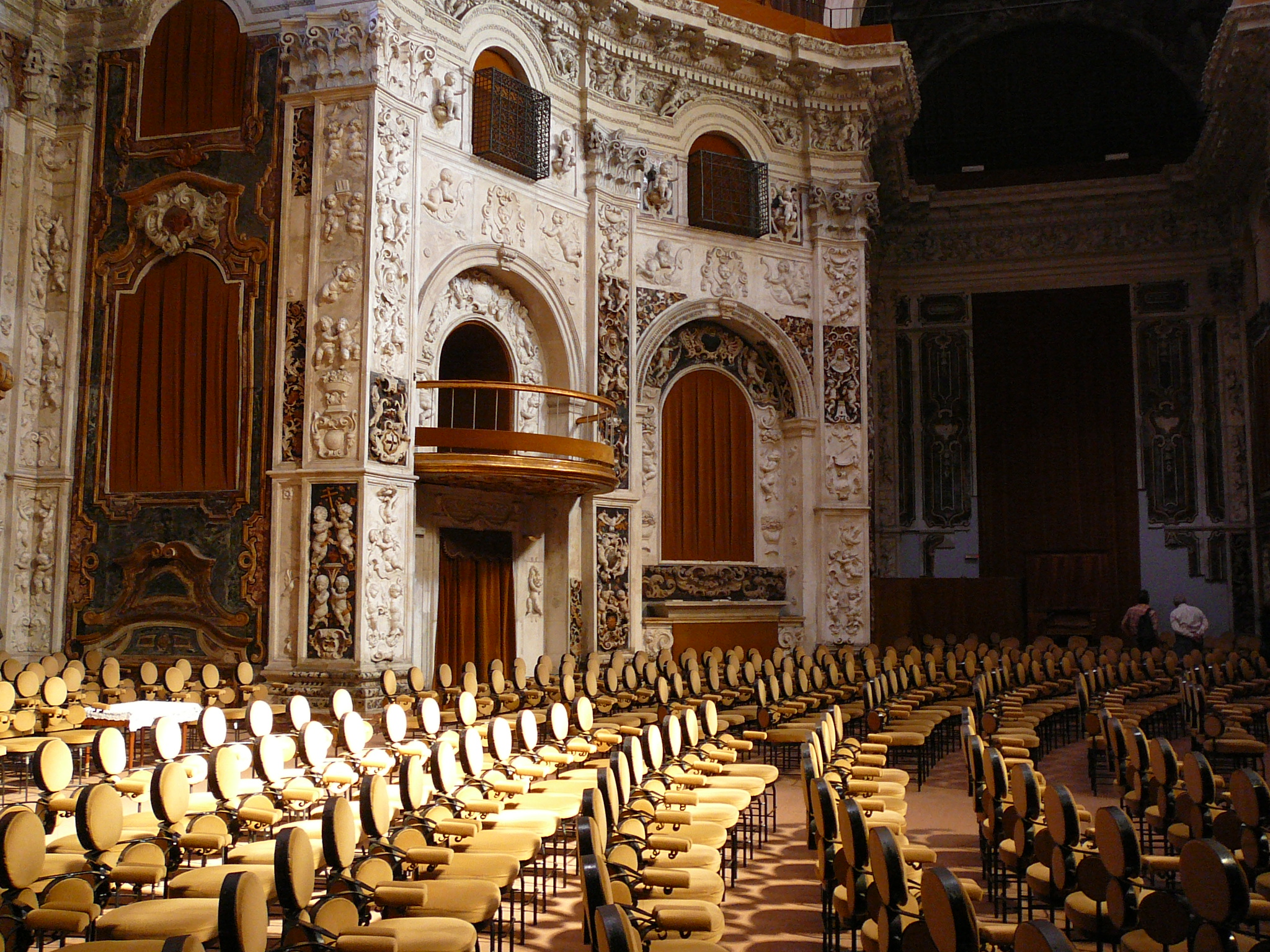 The Basilian monastery of SS. Salvatore and the annexed church were founded at the end of the 12th century, immediately after the Norman conquest of the city.
The Basilian monastery of SS. Salvatore and the annexed church were founded at the end of the 12th century, immediately after the Norman conquest of the city.
In 1528 the ancient Norman church was rebuilt in larger proportions divided into three naves and with the façade facing the current ascent of the SS. Savior. The vast void above the simple portal suggests that the façade has remained unfinished. In ’43 after a bombing the interior was totally destroyed and all the marble and stucco decorations including those of the dome ended up in dust. The church contained numerous works of art partly destroyed.
The building’s plan is an elongated dodecagon, circumscribed by an ellipse whose major axis is a continuation of the center of the entrance. The walls of the church are richly decorated with precious Sicilian polychrome marbles of the master Salvatore Allegra and, higher up, on the edge of the dome, by the stuccos of the master Francesco Alaimo. Inside there are three chapels, the largest of which is dominated by a small dome frescoed by Filippo Tancredi. The frescoes found on the walls of the entrance staircase belong to the painter Vito D’Anna and depict two episodes of the street of San Basilio: the healing of a child and the preaching of the Saint. To the painter Vito D’Anna also belongs the fresco of the dome, which reproduces the “Glory of Saint Basil”.
I CANDELAI
The Cultural Association I CANDELAI in via dei Candelai 65, in the heart of the historic center, was founded in January 1996 with the intention of giving life to a space that besides being a meeting point for people was also a point meeting of ideas, a point of reference and aggregation for anyone willing to propose and promote interesting and stimulating initiatives.
The structure of the space has a large hall on the ground floor and various spaces on the first floor. The space allowed the creation of a multipurpose center (space for exhibitions, conferences, concerts, shows, video projections, happenings, creative workshops, tea room, pub … ) and it is equipped with a room with audio-light system and a bar area.

